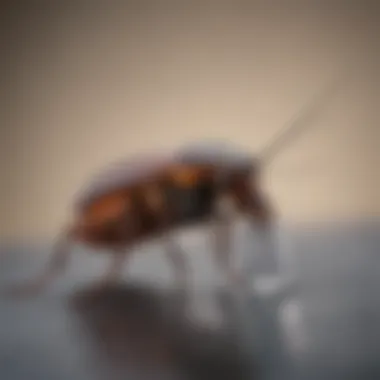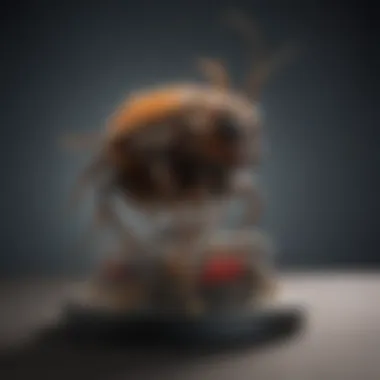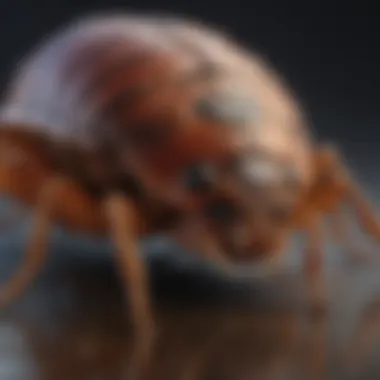The Role of Gentrol Roach Killer in Pest Management


Intro
In the realm of pest management, understanding how to effectively control populations of unwanted insects is crucial. Among the many tools available, Gentrol Roach Killer emerges as a notable option. This article examines the multifaceted role of Gentrol in pest management, focusing on its active ingredients, application methods, and eco-conscious integration within broader pest control strategies. By delving into its various aspects, homeowners and pest control professionals aim to make informed choices that prioritize both efficacy and environmental considerations.
Understanding Pests
Definition of Pests
Pests refer to organisms—usually insects—that are perceived as harmful to human interests. These may include damage to properties, health concerns, or interference with daily life. Common examples are cockroaches, ants, and rodents. Understanding what constitutes a pest is essential to developing effective management practices.
Importance of Pest Identification
Correctly identifying pests is fundamental in implementing an effective control strategy. Each species may respond differently to treatment methods. For instance, what works for German cockroaches might not be effective against American cockroaches. Knowledge about the specific type of pest not only enhances targeting but also reduces unnecessary pesticide use, making the approach more sustainable.
Prevention Techniques
Home and Garden Preventative Measures
Preventative techniques are the first line of defense against pest infestations.
- Regular Cleaning: Maintaining cleanliness in and around the home can significantly reduce hiding spots for pests.
- Sealing Entry Points: Inspecting and sealing gaps and cracks in doors, windows, and foundations can prevent pests from entering.
- Proper Waste Management: Keeping trash sealed and disposing of it regularly prevents attracting pests.
Seasonal Prevention Tips
Pest activity can vary with the seasons. Here are some insights:
- Spring: Conduct a thorough inspection of outdoor spaces. This is when many pests emerge after winter.
- Summer: Increase vigilance as warm weather encourages greater pest activity.
- Autumn: Prepare for pests seeking shelter indoors as temperatures drop.
Eco-Friendly Pest Control Solutions
Overview of Sustainable Practices
Integrating eco-friendly practices into pest management promotes sustainability. Strategies can include using traps or biological controls, such as employing natural predators of pests. These methods reduce reliance on chemical pesticides and minimize potential harm to the environment and other non-target species.
Natural Remedies and Their Effectiveness
Natural remedies can serve as alternatives to synthetic pesticides. Some popular options include:
- Diatomaceous Earth: A natural powder that can kill insects by causing desiccation when they come into contact with it.
- Essential Oils: Oils such as peppermint and tea tree can deter pests when used in sprays.
"Integrating natural remedies with chemical treatments may lead to better long-term results while being mindful of ecological impact."
Prelims to Gentrol Roach Killer
The context of pest management is critical for maintaining healthy living environments. Among various tools available, Gentrol Roach Killer emerges as a significant asset. Effective pest management seeks not just to eliminate pests but also to ensure that methods are safe for inhabitants and the environment. Gentrol Roach Killer serves as a strategic intervention against cockroach infestations, a common problem for many households.
Definition and Purpose
Gentrol Roach Killer is primarily designed to control cockroach populations. It contains specific ingredients that target the life cycle of cockroaches, preventing them from developing into adulthood. This innovative approach does not only kill existing roaches but inhibits the growth of future generations. For homeowners, this twofold action can drastically reduce the likelihood of recurring infestations. Gentrol’s use of IGR, or Insect Growth Regulator, signifies a shift from traditional methods. It enhances pest control by using biological mechanisms rather than only toxins.
Historical Context in Pest Control
The evolution of pest control reflects changing perspectives on health, safety, and pest management efficacy. Historical methods often relied heavily on broad-spectrum insecticides that killed a wide range of pests without regard for non-target species or health consequences. Gentrol Roach Killer is part of a modern approach that emphasizes targeted action and reduced risk. This shift began in the late 20th century as concerns about pesticide exposure emerged. Today, products like Gentrol signify progress towards integrated pest management. They are used in conjunction with other methods, optimizing results while minimizing adverse effects. This historical context is instrumental in understanding the significance of Gentrol Roach Killer in today’s pest control landscape.


Active Ingredients and Their Functionality
Understanding the active ingredients in Gentrol Roach Killer is crucial for evaluating its effectiveness and role in pest management. The efficacy of any pesticide lies in its composition and the specific functions its ingredients serve. Gentrol Roach Killer is designed to disrupt the life cycle of cockroaches, reducing their populations in a targeted manner. As such, knowing how each ingredient works can help homeowners and pest control experts optimize their use of this product.
Primary Ingredients
Gentrol Roach Killer primarily contains two active ingredients: Methoprene and Pyriproxyfen. Both ingredients belong to a class known as insect growth regulators (IGRs). They inhibit the development of juvenile cockroaches, preventing them from maturing into reproductive adults.
- Methoprene: This ingredient mimics the hormone that regulates growth in insects. By interfering with this natural process, Methoprene prevents cockroaches from reaching maturity. This is particularly important because adult cockroaches reproduce rapidly, and their control is essential in managing infestations.
- Pyriproxyfen: Similar to Methoprene, Pyriproxyfen also disrupts the growth process of immature cockroaches. It goes a step further by disrupting their ability to reproduce once they reach maturity. This dual action of the two ingredients is what makes Gentrol Roach Killer a valuable tool in managing cockroach populations effectively.
Mechanism of Action
The mechanism of action for Gentrol Roach Killer is fundamentally based on the principles of hormonal disruption. The active ingredients work by mimicking natural hormones that govern the development process in cockroaches.
- Growth Disruption: The presence of these IGRs in the environment modifies the growth and development cycle of young cockroaches. They are unable to transition from one life stage to the next.
- Reproductive Control: For mature cockroaches, exposure to these active ingredients means that their reproductive capabilities are inhibited. Therefore, even if an adult survives exposure to this product, it will not contribute to the population growth.
- Longevity: The effects of Gentrol Roach Killer last for a considerable time. This is because the active ingredients remain effective in the treated areas, giving ongoing protection against cockroach reinfestation.
In summary, the strategic use of Gentrol Roach Killer’s active ingredients provides a significant advantage in managing cockroach populations. Its focus on interrupting the life cycle and reproduction of these pests enhances its effectiveness.
Understanding these aspects is vital for effective pest management. Homeowners should consider these factors when choosing pest control methods to ensure that they are making informed decisions.
Application Methods for Gentrol Roach Killer
Understanding the application methods for Gentrol Roach Killer is crucial for effective pest management. Successful pest control hinges not just on the product used but also on how it is applied. Proper application ensures that the active ingredients are delivered effectively, maximizing both efficacy and safety. This section delves into best practices, recommended dosages, and common mistakes associated with the use of Gentrol Roach Killer. Each element is integral to achieving the best outcomes in controlling cockroach populations.
Best Practices for Application
Applying Gentrol Roach Killer requires precision and care. Here are some best practices:
- Clean the Area First: Remove food, dishes, and any items that may obstruct application. This creates a clear task environment.
- Use Protective Gear: Always wear gloves and a mask. This minimizes direct contact with the product, ensuring safety.
- Focus on Points of Entry: Apply Gentrol Roach Killer near cracks, crevices, and any locations seen as potential entry points for cockroaches.
- Even Distribution: Ensure a uniform coating when spraying or applying the product. This helps in maximizing surface area coverage.
- Follow Manufacturer’s Instructions: Refer to the product label for guidance specific to Gentrol Roach Killer. Adequate understanding of the guidelines is key to effective usage.
"Pest control is as much about application as it is about the product used. Proper methodology ensures the desired results."
Recommended Dosage and Frequency
Getting the right dosage of Gentrol Roach Killer is essential for its success. Common recommendations include:
- Initial Application: Usually involves a higher dosage to effectively eliminate existing cockroach populations.
- Regular Maintenance: After the initial treatment, a reduced dosage is recommended for upkeep. This prevents re-infestation.
- Timing of Applications: Typically, applications should occur every few weeks. However, this can vary based on the severity of the infestation and environmental factors.
It is crucial to follow the manufacturer's guidelines in detail. Overuse can lead to resistance, while underuse may not effectively manage the pest problem.
Common Mistakes to Avoid
Even experienced users can make errors that minimize the effectiveness of Gentrol Roach Killer. Here are frequent pitfalls:
- Not Prepping the Area: Failing to clean the space before application can reduce the product's effectiveness. Cockroaches are smart and often avoid treated areas if they sense disturbance.
- Ignoring Label Directions: Every product is different. Not adhering strictly to the instructions can lead to either ineffectiveness or unsafe situations.
- Inconsistent Application: Skipping certain spots or applying unevenly can result in poor coverage, allowing cockroaches to thrive.
- Neglecting Safety Precautions: Many underestimate the need for protective gear. Always utilize gloves and masks to protect against potential irritants or harmful effects.
In summary, understanding how to properly apply Gentrol Roach Killer is essential for achieving effective pest control. By adhering to best practices, following the recommended dosage and frequency, and avoiding common mistakes, homeowners and pest control professionals can gain an advantage in managing cockroach infestations.
Safety and Environmental Considerations
In discussions regarding pest management, understanding safety and environmental considerations becomes crucial. This topic not only assures the well-being of humans but also safeguards beneficial insect populations. Knowledge about Gentrol Roach Killer usage is essential, as it helps inform effective application to minimize risks while managing cockroach infestations.
Human Safety Protocols
Using Gentrol Roach Killer requires adherence to specific safety protocols to protect individuals in and around the treated areas. First, it is vital to read the label and adhere to the provided guidelines before application. Appropriate personal protective equipment (PPE) should be worn, including gloves and masks, to avoid inhalation or skin contact with the pesticide.


- Ventilation: Ensure the area is well-ventilated during and after application. Proper airflow can help disperse any lingering chemicals in the air.
- Separation: Keep children and pets away from treated surfaces for a specified period. This precaution protects them from potential exposure.
- Spillage Protocol: In case of spillage, follow the specifics in the material safety data sheet (MSDS). Cleanup should be immediate to reduce hazards.
Implementing these safety measures enhances effectiveness in dealing with infestations while minimizing health risks.
Impact on Beneficial Insects
While Gentrol Roach Killer effectively targets cockroach populations, its application can inadvertently affect beneficial insects. This impact necessitates careful consideration to maintain ecological balance.
- Selectivity: Understanding the selectivity of Gentrol's active ingredients is important. These ingredients are often formulated to specifically disrupt cockroach development, causing less harm to nontarget species.
- Timing of Application: Applying the product when beneficial insects are least active can mitigate unintended consequences. This consideration helps protect essential insects like bees and predatory bugs that contribute positively to ecosystems.
- Localized Treatment: Applying Gentrol Roach Killer directly to infested areas rather than widespread spraying reduces exposure risk to beneficial insects. This approach is more effective and environmentally responsible.
Protecting beneficial insects is crucial for maintaining biodiversity and the functioning of ecosystems. Careful use of pesticides is necessary to support sustainable pest management.
In summary, prioritizing human safety protocols and being aware of the impact on beneficial insects are integral to the responsible use of Gentrol Roach Killer. It combines pest management efficiency with ecological health, ensuring a balanced approach to controlling roach populations.
Effectiveness of Gentrol Roach Killer
The effectiveness of Gentrol Roach Killer plays a pivotal role in its adoption by both homeowners and pest control professionals. Its ability to target cockroach populations specifically makes it a valuable tool in pest management strategies. Understanding how it works in relation to other pest control methods can inform better usage choices and enhance results for those looking to mitigate infestations.
Comparative Analysis with Alternatives
Comparing Gentrol Roach Killer with its alternatives helps consumers understand its unique strengths. Many traditional insecticides focus on killing roaches on contact, using powerful chemicals that risk harming non-target species and beneficial insects. On the other hand, Gentrol Roach Killer uses a growth regulator called metoprene, which interrupts the life cycle of cockroaches. This mechanism reduces the chances of emerging infestations, providing a more long-term solution.
Some alternatives might be less targeted, but they may have a broader kill spectrum. Products like Ortho Home Defense or Raid contain active ingredients like bifenthrin and imiprothrin that kill on contact. These options can be effective, however, they may require repeated applications and can lead to resistance in roach populations. Here are some additional points of comparison:
- Target Specificity: Gentrol’s targeted action minimizes collateral damage.
- Sustainability: As a growth regulator, Gentrol offers a solution that is less harsh on the environment compared to traditional insecticides.
- Behavioral Impact: Gentrol not only kills but also prevents future generations. Its residual effect can last up to several months.
Peer-reviewed Studies and Evidence
Research supports the claims surrounding Gentrol Roach Killer's effectiveness. Various peer-reviewed studies highlight its role in Integrated Pest Management (IPM) strategies. The Journal of Economic Entomology published findings demonstrating significant reductions in cockroach populations with the use of growth regulators like metoprene.
In one study, researchers evaluated Gentrol alongside other pesticide treatments. The results showed a marked decrease in adult cockroach numbers and effective inhibition of nymph development. This indicates that when used in conjunction with traditional killing methods, Gentrol can enhance overall control strategies. Further investigations are important to continue asserting the effectiveness of Gentrol and refine pest management practices.
"Gentrol Roach Killer provides a preventive measure against cockroach reproduction that traditional products do not offer."
Integration with Other Pest Management Strategies
Effectively managing cockroach populations requires a multi-faceted approach. Gentrol Roach Killer plays a pivotal role within this larger context of pest control. Integrating it with other pest management strategies maximizes its effectiveness and minimizes potential risks. To achieve this, it is essential to understand complementary pesticides and the implementation of integrated pest management plans.
Complementary Pesticides
When using Gentrol Roach Killer, considering complementary pesticides can enhance the overall effectiveness of a pest management strategy. These pesticides may target different life stages of cockroaches or employ various mechanisms of action, which can lead to better control of infestations.
Here are some common complementary pesticides:
- Boric Acid: This substance is effective against adult and nymph cockroaches by disrupting their digestive systems. Its long-lasting properties make it suitable for use alongside Gentrol, which mainly disrupts reproduction.
- Insect Growth Regulators (IGRs): While Gentrol is already an IGR, using them alongside other targeted IGRs can further suppress growth in cockroach populations. This can lead to more significant control of long-term infestations.
- Pyrethrins: Derived from chrysanthemums, these natural insecticides affect the nervous systems of cockroaches. They can be used in conjunction with Gentrol for immediate knockdown of adult populations, while the IGR continues to prevent future generations.
The integration of Gentrol with these products can provide a comprehensive strategy that addresses different life stages and behaviors in cockroaches.
Implementing an Integrated Pest Management Plan
Creating an Integrated Pest Management (IPM) plan includes strategies like sanitation, monitoring, and pesticide application. Each of these plays a critical part in successful cockroach management.
- Sanitation: Keeping living spaces clean reduces food and habitat for cockroaches. Remove possible sources of attraction, such as food residues or clutter. This practice supports the effectiveness of Gentrol and other treatments since fewer cockroaches means less infestation for the product to address.
- Monitoring: Regular inspections help identify infestation levels. Sticky traps can be placed in strategic locations to assess roach populations and help determine when to apply Gentrol.
- Pesticide Application: Using Gentrol according to label instructions within an IPM framework maximizes its benefits. By understanding when to apply Gentrol alongside sanitation efforts and other pesticides, it helps in maintaining a less favorable environment for cockroaches.
"Integrating multiple strategies ensures a holistic approach rather than solely relying on one product."


By utilizing a comprehensive plan that includes Gentrol Roach Killer while considering complementary products, homeowners can effectively manage cockroaches and reduce their presence significantly.
Legal and Regulatory Aspects
Understanding the legal and regulatory aspects of Gentrol Roach Killer is crucial for both consumers and pest management professionals. Compliance with these regulations ensures the safe and effective use of the product while minimizing potential risks to human health and the environment. This section provides an overview of the importance of these facets in pest management, focusing on registration processes, consumer rights, and responsibilities.
Registration and Regulation Overview
The registration of Gentrol Roach Killer involves a thorough assessment by regulatory bodies such as the United States Environmental Protection Agency (EPA). This process ensures that the product meets specific safety and efficacy standards before it can be marketed and sold. Key factors evaluated during registration include:
- Active ingredients: Safety evaluations of the substances used in the formulation to determine potential risks.
- Usage instructions: Clarity in how to apply the product safely and effectively.
- Environmental impact: Assessing any possible effects on non-target species and ecosystems.
Maintaining compliance with these regulations is vital not just for legal operation but also for building trust with consumers. This ongoing oversight helps to prevent misuse of the product, further safeguarding public health and the environment.
Consumer Rights and Responsibilities
Consumers who purchase Gentrol Roach Killer are entitled to certain rights under regulatory frameworks. Key rights include:
- Access to Safety Information: Users should have easy access to detailed information about the potential hazards associated with the product.
- Right to Redress: In case of adverse effects caused by improper product usage, consumers have the right to seek compensation or report incidents to relevant authorities.
Equally important are the responsibilities consumers must uphold. These include:
- Following Usage Instructions: Adhering closely to the application guidelines provided by the manufacturer ensures safety and effectiveness.
- Proper Storage: Keeping the product out of reach of children and pets to prevent accidental exposure.
- Reporting Issues: Alerting regulatory bodies about any negative effects or unsafe conditions related to its use.
Future of Cockroach Management
The future of cockroach management is a pivotal consideration for both homeowners and pest control professionals. Understanding evolving trends helps address the persistent challenge of cockroach infestations effectively. This section explores emerging practices and innovative research directions, which are increasingly focused on sustainability and efficacy in pest management strategies.
Emerging Trends in Pest Control
Recent years have witnessed a shift in pest control approaches, guided by advancements in technology and environmental concerns. An important trend is the integration of smart technology in pest management. Devices equipped with sensors can detect pest activity and notify homeowners in real time. This proactive approach allows for targeted interventions rather than widespread pesticide application, reducing chemical exposure.
Another significant trend is the adoption of biological control methods. Utilizing natural predators, like certain parasitic wasps, can limit cockroach populations without harming beneficial insects. Furthermore, continuous advancements in low-impact insecticides, such as those that target specific life stages of cockroaches, are gaining traction. These alternatives offer a balanced way to manage pests while maintaining ecological integrity.
Moreover, educational resources and community engagement have become vital tools. As more homeowners seek to understand pest biology and prevention methods, informational workshops and online platforms play a crucial role. This knowledge empowers individuals to adopt proactive measures, thus mitigating infestations before they escalate.
Research Directions and Innovations
Going forward, research in cockroach management will likely prioritize integrated pest management (IPM) techniques. Studies are increasingly focusing on mixing traditional methods with innovative solutions. Research aims to identify synergistic approaches that maximize effectiveness while minimizing risks to health and the environment.
A notable direction of this research is the exploration of genetic studies. Insights into the cockroach genome could lead to developing targeted pest control strategies, potentially rendering conventional approaches obsolete. Understanding regulatory genes for reproduction and resistance can provide pathways for innovative control methods.
Additionally, increasing attention is directed toward the use of fermentation processes to create microbial insecticides. This method harnesses naturally occurring microbes to disrupt cockroach biology. Such innovations highlight a significant shift toward environmentally sustainable solutions.
End
The conclusion serves as the capstone of the article, summarizing critical elements about Gentrol Roach Killer's role in effective pest management. In this examination, we highlighted the product's active ingredients, how they work, and the integration of Gentrol into broader pest management strategies. It is essential to recognize that utilizing Gentrol can significantly enhance the effectiveness of pest control efforts in households.
By providing a detailed overview of application methods, safety measures, and environmental considerations, we have aimed to equip homeowners with the necessary knowledge and tools to use Gentrol responsibly and effectively. Ultimately, the goal is to ensure that pest management is not only effective but also sustainable, minimizing ecological disruption while tackling common household pests.
"Successful pest management involves understanding the product and its context in the broader pest control landscape."
Summary of Key Points
- Active Ingredients: Gentrol Roach Killer uses specific ingredients like hydroprene to disrupt the life cycle of roaches.
- Mechanism of Action: It primarily functions as an insect growth regulator, preventing young roaches from maturing into reproductive adults.
- Application Methods: Correct application methods, including dosage and frequency, were discussed to ensure optimal effectiveness.
- Safety Considerations: Importance of following safety protocols for both humans and beneficial insects was described.
- Integration with Other Strategies: Gentrol’s role in conjunction with other pest management techniques promotes a comprehensive approach to pest control.
- Legal and Regulatory Aspects: Understanding the regulations surrounding the usage of such products is crucial for compliance and safe application.
Final Thoughts on Its Application
Gentrol Roach Killer represents a progressive approach in pest management, particularly in environments where sustainability is a priority. It is designed to address the growing challenges posed by cockroaches effectively while being mindful of both human health and the environment.
Homeowners should consider Gentrol not just as a stand-alone solution, but rather as part of an integrated pest management system. This approach allows for adaptive strategies based on specific pest activity and habitats. As research increases and more innovative treatments emerge, products like Gentrol will play a vital role in the evolution of pest management strategies that prioritize both effectiveness and ecological responsibility.



